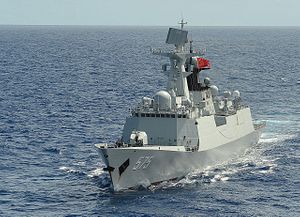In mid-March, the hijacking of a merchant fuel tanker off the coast of Somalia jolted the world of maritime shipping. Somalia’s infamous pirates had announced their return. Fortunately, in their relative period of dormancy since 2012 — the date of the last attempted hijacking of a large vessel — much has changed about the maritime environs of the western Indian Ocean and the Gulf of Aden.
One of the bigger changes in recent years has been the increased presence of the Chinese People’s Liberation Army Navy (PLAN), which has taken to the western Indian Ocean region as it becomes an increasingly global navy with expeditionary aspirations. Readers of the The Diplomat, for instance, may recall China setting up its first overseas naval facility in Djibouti, with the intention of establishing a logistical supply base in the area to support PLAN counter-piracy operations.
Last week, the PLAN had a major moment in the Gulf of Aden, one that Beijing will no doubt use to point to its benign intentions in Djibouti. Along with Indian Navy vessels that were en route to the Mediterranean, a Chinese team from the Type 054A PLAN Yulin (pennant number 569) responded to a distress signal from a Tuvalu-flagged bulk carrier, OS 35.
The ship, it turned out, had been attacked by pirates. According to Indian reports, “Indian Navy provided communication and air support to the PLA’s naval division which entered the ship to sanitize it.” Indian Navy ships involved in the incident included the Delhi-class guided missile destroyer INS Mumbai, the Talwar-class frigates INS Tarkash and INS Trishul, and Aditya-class replenishment and repair ship INS Aditya.
Chinese reports, for instance in the state-run People’s Daily, noted that the crew of the Yulin boarded the OS 35 to secure the ship. People’s Daily additionally showed off imagery of the ship’s crew thanking the PLAN rescue team, even highlighting that the “crew members placed Chinese national flags on their heads to express gratitude to their rescuers.” Above all, nowhere did the Chinese reports mention any Indian assistance in the operation.
Meanwhile, in the characteristically nationalistic Global Times, celebration rang out. In an article titled “Gulf of Aden rescue demonstrates mission of PLA Navy,” an author argued that “China has actively engaged in international anti-piracy operations in recent years… [but] the Chinese navy has not been applauded for its efforts, and instead has been subject to overwhelming suspicions.”
“Many Western media outlets and Western strategists have maliciously hyped China’s intention of improving its naval strength… it is imperative for Beijing to build a powerful navy that can protect arterial maritime trade routes and defend the country’s growing international interests,” the article continued.
Both the presentation of the operation in the People’s Daily and this analysis in the Global Times highlight the public relations problem that China faces with its turn toward an expeditionary navy. Beijing has justified its activities in the western Indian Ocean region by claiming that it is there to defend the global commons and protect public goods just like the U.S. and Indian Navy claim to do with less skepticism. China calls its Djibouti base, which will sit adjacent to the United States’ Camp Lemonnier, a “support facility.”
Interestingly, both the OS 35 incident and a separate hijacking incident in the Gulf of Aden on Saturday may have seen the PLAN’s first use of lethal force against pirates. On Saturday, two Somali pirates were shot dead while trying to hijack an unknown ship by what Voice of America reported as “foreign naval forces.” The VOA report’s timing coincides with reporting in Chinese state media of another PLAN vessel, the PLAN Henyang, rescuing a Panamanian-flagged vessel, the Alheera. Though the fate of the pirates in the OS 35 remains uncertain, it is likely that the same pirates reported to be killed by VOA were involved in the Alheera incident (the only reported piracy incident in the Gulf of Aden during that time).
The PLAN had earlier made its presence felt in the area when it became involved in evacuation operations back in March 2015, when the Saudi Arabia-led intervention in Yemen was just starting. The Indian Navy also played a part in those evacuations. Even back then, we saw public messaging out of China highlighting that the increasingly global role for the PLA was focused not on wily geopolitical machinations, but on humanitarian ends.
An April 2015 analysis in the PLA Daily cited Rear Admiral Du Jingchen, the then-deputy commander of the PLAN, who highlighted the PLAN’s diverse mission set in the western Indian Ocean and the Mediterranean:
The Chinese naval fleets have provide escort service for 5,900-plus Chinese and foreign civil ships in 825 batches. At the same time, they also successfully completed some important and emergency tasks such as evacuating Chinese nationals from Libya, escorting the maritime transportation of chemical weapons from Syria, providing emergency water supply to Maldives as well as evacuating Chinese citizens from Yemen.
The problem for China, however, continues to be that its activities elsewhere — particularly in its near seas — undermine its credibility afar. Even if the Djibouti base is intended to support logistics for operations like the rescue mission for the crew of the OS 35, China’s continued non-compliance with international law in the South China Sea and its own peculiar definition of freedom of navigation that discriminates between civilian and military vessels will leave others — including the United States and India — doubtful of its intentions in the Indian Ocean.

































